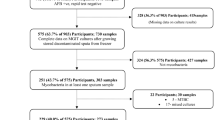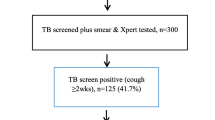Abstract
The gold standard for diagnosing pulmonary TB is to detect Mycobacterium tuberculosis (M. TB) in a human specimen. Case detection methods vary depending on the medical resources and economic conditions in each region. These methods can be either passive, in which case the disease is diagnosed after the patient has had a consultation, or active, when infections are detected via screening and medical examination. In countries with low TB prevalence, passive case detection is the primary method used, and clinicians deal with many other diseases as well, so various tests have been developed to diagnose pulmonary TB and other diseases. Passive case detection is used in areas where TB is widespread and in populations in which infections are particularly common, especially when medical resources, efficient diagnostic methods, and commonly used tests are limited in the area. Thus, the choice of diagnostic method used depends strongly on the local situation. The number of TB patients worldwide is gradually declining in most countries. To accelerate the decline in infections, the World Health Organization (WHO) has devised various measures for bacterial testing in the focal region. In 2021, the WHO once again recommended rapid and accurate sputum testing to increase the number of patients for whom treatment is initiated and to accelerate and improve the efficiency of TB diagnosis. This is being done with the aim of reducing the number of patients, deaths, and cases with multidrug-resistant TB not just drug-sensitive TB. The WHO has recommended converting from the conventional smear method to the nucleic acid amplification test (NAAT). As culture tests are expensive, it is recommended that patients be triaged first via symptomatic screening and digital imaging tests to reduce the number of target patients, after which the NAAT should be performed. For this triage process, testing methods using human specimens that can be obtained more easily are under development. There are many benefits to early detection of pulmonary TB and rifampicin (RFP)-resistant cases. However, in countries where the prevalence of TB has declined, the diagnosis of other diseases is also important, so approaches such as bronchoscopy and positron emission tomography (PET) are used for patients who cannot be diagnosed using the NAAT. The onset of TB in people living with HIV (PLWHIV) has become a major problem of this coinfection, regardless of the local prevalence of TB. Lipoarabinomannan has been developed as a biomarker for this population, and since it uses an easily available sample (urine), it is used both in the triage process and in the low-prevalence areas. Many diagnostic methods will be developed in the future, but the latest approach to diagnosing TB is to suspect it and then perform a NAAT.
Access this chapter
Tax calculation will be finalised at checkout
Purchases are for personal use only
Similar content being viewed by others
References
World Health Organization. Global TB report 2020. 2020. https://apps.who.int/iris/bitstream/handle/10665/336069/9789240013131. Accessed 10 May 2020.
Conradie F, Diacon AH, Ngubane N, Howell P, Everitt D, Crook AM, et al. Nix-TB trial team. Treatment of highly drug-resistant pulmonary tuberculosis. N Engl J Med. 2020;382:893–902.
Miller LG, Asch SM, Yu EI, et al. A population-based survey of TB symptoms: how atypical are atypical presentations? CID. 2000;2000(30):293–9.
World Health Organization. Systematic screening for active TB Principles and recommendations. 2013. https://www.who.int/tb/publications/Final_TB_Screening_guidelines.pdf. Accessed 21 May 2021.
Field SK, Escalante P, Fisher DA, Ireland B, Irwin RS. And CHEST expert cough panel, cough due to TB and other chronic infections, CHEST guideline and expert panel report. Chest. 2018;153:467–97.
World Health Organization. Diagnostic and treatment delay in TB. 2009. https://apps.who.int/iris/bitstream/handle/10665/116501/dsa710.pdf?sequence=1&isAllowed=y. Accessed 21 May 2021.
Cai J, Wang X, Ma A, Wang Q, Han X, Li Y. Factors associated with patient and provider delays for TB diagnosis and treatment in Asia: a systematic review and meta-analysis. PLoS One. 2015;10(3):e0120088. https://doi.org/10.1371/journal.pone.0120088.
Quattrocchi A, Barchitta M, Nobile CGA, Prato R, Sotgiu G, Alessandra Casuccio A, Vitale F, Agodi A. CCM 2013 TB network. Determinants of patient and health system delay among Italian and foreignborn patients with PULMONARY TB: a multicentre cross-sectional study. BMJ Open. 2018 https://doi.org/10.1136/bmjopen-2017-019673.
Sasaki Y, Yamagishi F, Suzuki K, Kuriyama T. Patient’s delay and doctor’s delay in the pulmonary tuberculosis. Kekkaku. 1996;71:303–9.
World Health Organization. Same-day diagnosis of TB by microscopy: WHO policy statement. 2011. http://www.who.int/iris/handle/10665/44603#sthash.gvkTkPOD.dpuf. Accessed 21 May 2021.
World Health Organization. Section 1. Molecular assays intended as initial tests for TB. In WHO consolidated guidelines on TB. Module 3: diagnosis–rapid diagnostics for TB detection. 2020. https://www.who.int/publications/i/item/who-consolidated-guidelines-on-tuberculosis-module-3-diagnosis-rapid-diagnostics-for-tuberculosis-detection. Accessed 21 May 2021.
Luo W, Lin Y, Li Z, Wang W, Shi Y. Comparison of sputum induction and bronchoscopy in diagnosis of sputum smear-negative pulmonary tuberculosis: a systemic review and meta-analysis. BMC Pulm Med. 2020; https://doi.org/10.1186/s12890-020-01192-w.
Theron G, Peter J, Meldau R, Khalfey H, Gina P, Matinyena B, Lenders L, Govender U, Satshedu M, Dheda K. Accuracy and impact of Xpert MTB/RIF for the diagnosis of smear-negative or sputum-scarce tuberculosis using bronchoalveolar lavage fluid. Thorax. 2013;68:1043–51.
Broger T, Sossen B, Toit E, Kerkhoff AD, Schtz C, Reipold EI, et al. A novel lipoarabinomannan point-of-care TB test for people with HIV: a diagnostic accuracy study. Lancet Infect Dis. 2019;19:852–61.
World Health Organization. Commercial serodiagnostic tests for diagnosis of TB. Policy statement. 2011. http://apps.who.int/iris/bitstream/10665/44652/1/9789241502054_eng.pdf. Accessed 20 May 2021.
Phillips M, Basa-Dalay V, Blais J, Bothamley G, Chaturvedi A, Modi KD, et al. Point-of-care breath test for biomarkers of active Pulmonary TB. Tuberculosis (Edinb). 2012;92:314–20.
Goletti D, Lee MR, Wang JY, Walter N, Ottenhoff THM. Update on TB biomarkers: from correlates of risk, to correlates of active disease and of cure from disease. Respirology. 2018;23:455–66.
World Health Organization. WHO consolidated guidelines on TB. Module 2: screening–systematic screening for TB disease. 2021. https://www.who.int/Publications/i/item/9789240022676. Accessed 24 May 2021.
Kung BT, Seraj SM, Zadeh MZ, Rojulpote C, Kothekar E, Ayubcha C, et al. An update on the role of 18F-FDG-PET/CT in major infectious and inflammatory diseases. Am J Nucl Med Mol Imaging. 2019;9:255–73.
Demura Y, Tsuchida T, Ishizaki T, Mizuno S, Totani Y, Ameshima S, Miyamori I, Sasaki M, Yonekura Y. 18F-FDG accumulation with PET for differentiation between benign and malignant lesions in the thorax. J Nucl Med. 2003;44:540–8.
Schaaf HS, Collins A, Bekker A, Davies PD. Tuberculosis at extremes of age. Respirology. 2010;15:747–63.
Tebruegge M, de Graaf H, Sukhtankar P, Elkington P, Marshall B, Schuster H, et al. Extremes of age are associated with indeterminate Quanti FERON-TB gold assay results. J Clin Microbiol. 2014;52:2694–7.
World Health Organization: Guidelines for intensified tuberculosis case-finding and isoniazid preventive therapy for people living with HIV in resource-constrained settings. 2011. http://apps.who.int/iris/bitstream/handle/10665/44472/9789241500708_eng.pdf?sequence=1. Accessed 24 May 2021.
Jones BE, Young SM, Antoniskis D, Davidson PT, Kramer F, Barnes PF. Relationship of the manifestations of tuberculosis to CD4 cell counts in patients with human immunodeficiency virus infection. Am Rev Respir Dis. 1993;148:1292–7.
Fox GJ, Barry SE, Britton WJ, Marks GB. Contact investigation for tuberculosis: a systematic review and meta-analysis. Eur Respir J. 2013;41:140–56.
The National Tuberculosis Controllers Association and Centers for Disease Control and Prevention. Guidelines for the investigation of contacts of persons with infectious tuberculosis; recommendations from the National Tuberculosis Controllers Association and CDC. MMWR. 2005;54:1–48.
Author information
Authors and Affiliations
Editor information
Editors and Affiliations
Rights and permissions
Copyright information
© 2022 The Author(s), under exclusive license to Springer Nature Singapore Pte Ltd.
About this chapter
Cite this chapter
Sasaki, Y. (2022). Advances in Diagnostics of Pulmonary TB: What Is the Latest Approach to Diagnose Pulmonary TB?. In: Saito, T., Narita, M., Daley, C.L. (eds) Pulmonary Tuberculosis and Its Prevention. Respiratory Disease Series: Diagnostic Tools and Disease Managements. Springer, Singapore. https://doi.org/10.1007/978-981-19-3995-2_5
Download citation
DOI: https://doi.org/10.1007/978-981-19-3995-2_5
Published:
Publisher Name: Springer, Singapore
Print ISBN: 978-981-19-3994-5
Online ISBN: 978-981-19-3995-2
eBook Packages: MedicineMedicine (R0)




